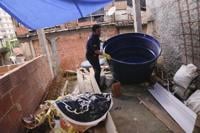When the coronavirus pandemic took hold in an unprepared U.S., states scrambled for masks and other protective gear.
Three years later, as the grips of the pandemic have loosened, many states are now trying to deal with an excess of protective gear, ditching their supplies in droves.
With expiration dates passing and few requests to tap into its stockpile, Ohio auctioned off 393,000 gowns for just $2,451 and ended up throwing away another 7.2 million, along with expired masks, gloves and other materials. The now expiring supplies had cost about $29 million in federal money.
A similar reckoning is happening around the country. Items are aging, and as a deadline to allocate federal COVID-19 cash approaches next year, states must decide how much to invest in maintaining warehouses and supply stockpiles.
An Associated Press investigation found that at least 15 states, from Alaska to Vermont, have tossed some of their trove of PPE because of expiration, surpluses and a lack of willing takers.
Into the trash went more than 18 million masks, 22 million gowns, 500,000 gloves, and more. That’s not counting states that didn’t give the AP exact figures or responded in cases or other measures. Rhode Island said it got rid of 829 tons of PPE; Maryland disposed of over $93 million in supplies.
“What a real waste. That’s what happens when you don’t prepare, when you have a bust-and-boom public health system,” where a lack of planning leads to panicked over-purchasing in emergencies, said Dr. Georges Benjamin, executive director of the American Public Health Association. “It shows that we really have to do a better job of managing our stockpiles.”
The AP sent inquiries about PPE stockpiles to all 50 states over the past several months. About half responded.
States emphasize that they distributed far more gear than they discarded and have gone to great lengths to donate the leftovers. Washington state sent hundreds of thousands of supplies to the Marshall Islands last year, yet ended up throwing out millions more items after they expired.
Many states are keeping at least a portion, and sometimes all, of their remaining protective gear. Some even plan to update their stockpiles.
But others say the vagaries of the pandemic and the PPE supply left no choice but to acquire the items, and now to throw them out, however reluctantly. Expiration dates are set because materials can degrade and might not work as intended. The Federal Emergency Management Agency has set the fair market value of expired supplies at zero dollars.
“Anytime you’re involved in a situation where you’re recalling how difficult it was to get something in the first place, and then having to watch that go or not be used in the way it was intended to be used, certainly, there’s some frustration in that,” said Louis Eubank, who runs the South Carolina health department’s COVID-19 coordination office. The state has discarded over 650,000 expired masks.
When the virus struck, demand skyrocketed for N95 masks, gloves and gowns. The U.S government’s Strategic ��ɫtv Stockpile , and states plunged into .
The AP found in 2020 that states in a few months on PPE, ventilators and some other high-demand medical devices in a seller’s market. Ultimately, the federal government paid for many of the supplies.
“There was no way to know, at the time of purchase, how long the supply deficit would last or what quantities would be needed,” Ohio Department of Health spokesperson Ken Gordon said.
Ohio distributed more than 227 million pieces of protective equipment during the pandemic. But as the supply crunch and the health crisis eased, demand faded, .
Now, “states, hospitals, manufacturers – everybody in the whole system -- has extra product,” said Linda Rouse O’Neill of the Health Industry Distributors Association.
Given the glut, stockpiled items are selling for bargain prices, if at all. Vermont got $82.50 for 105,000 boot covers and 29 cents apiece for thousands of safety goggles.
Striking a balance between preparedness and surpluses is “a major dilemma” for governments, said Scott Amey of the Project on Government Oversight, a Washington, D.C.-based watchdog group. And while politicians vowed in 2020 never to be caught off guard again, “memories are short, budgets are tight,” Amey noted.
In Wisconsin, a legislative committee axed from the budget a warehouse with an ongoing 60-day supply of PPE for two years.
The state Department of Health Services said it is now “demobilizing the warehouse” and trying to donate the supplies. Already, Wisconsin has tossed nearly 1.7 million masks and almost 1 million gowns.
Minnesota’s Department of Health was allocated some money this year for retaining and restocking PPE and is strategizing. For now, emergency response official Deb Radi says the agency expects to dispose of a few expiring gowns.
The Health Industry Distributors Association recommends that product distributors maintain a 60-to-90-day supply to guard against demand spikes. But the group says it’s probably unnecessary for everyone in the system — from manufacturers to doctors’ offices — to have such a large cushion.
Missouri’s health department has maintained a 90-day supply, keeping even expired materials on the presumption that the federal government will OK their use in an emergency. That happened during COVID-19.
“If you don’t make the investment – and perhaps the investment that is never used – then you may not be prepared to assist the public when it’s needed,” Missouri health director Paula Nickelson said.
Pennsylvania officials, by contrast, are aiming for a 15-day stockpile after frank conversations about what they can afford not only to keep, but to keep replacing as items expire, said Andy Pickett, the Health Department’s emergency preparedness and response director.
And Nevada can't give its aging PPE away fast enough.
Department of Administration Director Jack Robb said the state is endeavoring to shed the supplies safely and without wasting money but already has discarded some.
But Robb said officials “made the best decisions that they could” when confronted with a disease that has killed nearly 7 million people worldwide, including some of his close friends.
“And I hope we never see anything like that again in our lifetime,” he said.










































